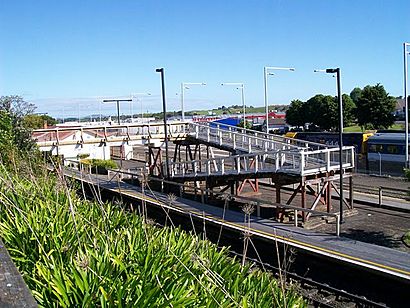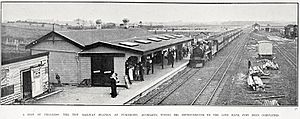Pukekohe railway station facts for kids
Quick facts for kids
Pukekohe
|
|||||||||||||||||||||
|---|---|---|---|---|---|---|---|---|---|---|---|---|---|---|---|---|---|---|---|---|---|
| Auckland Transport Urban rail | |||||||||||||||||||||

Looking south from Station Road.
|
|||||||||||||||||||||
| Location | 40 Station Road, Pukekohe, New Zealand | ||||||||||||||||||||
| Coordinates | 37°12′12″S 174°54′36″E / 37.203333°S 174.910000°E | ||||||||||||||||||||
| Owned by | KiwiRail (track and platforms) Auckland Transport (buildings) |
||||||||||||||||||||
| Line(s) | Southern Line | ||||||||||||||||||||
| Distance | Wellington 628.86 km (390.76 mi) | ||||||||||||||||||||
| Platforms | Island platform | ||||||||||||||||||||
| Tracks | Mainline (2) | ||||||||||||||||||||
| Construction | |||||||||||||||||||||
| Platform levels | 1 | ||||||||||||||||||||
| Parking | Yes | ||||||||||||||||||||
| Bicycle facilities | No | ||||||||||||||||||||
| History | |||||||||||||||||||||
| Opened | 20 May 1875 | ||||||||||||||||||||
| Rebuilt | 1913 | ||||||||||||||||||||
| Electrified | No | ||||||||||||||||||||
| Traffic | |||||||||||||||||||||
| Passengers (2018-19) | 269,000 | ||||||||||||||||||||
| Services | |||||||||||||||||||||
|
|||||||||||||||||||||
Pukekohe railway station is an important train stop in Pukekohe, New Zealand. It's the very last stop on the Southern Line of Auckland's train network, but electric trains don't go this far yet. The station has a special platform called an island platform (which means it's in the middle of two tracks) and an old wooden building with a signal panel.
Back in 1882, Pukekohe was about 48 kilometers (30 miles) south of Auckland. The station was rebuilt in 1913, moving it further south from the town center. In 1941, it was changed to an island platform, and more upgrades started in 2016.
Contents
The Story of Pukekohe Station
The train line reached West Pukekohe in 1873. The full line to Mercer opened on May 20, 1875. The new station helped the town center of Pukekohe grow around King Street.
In 1875, a station building and a house for the stationmaster were built using rimu and kauri wood. Over the years, more features were added, like:
- a way for carts to reach the platform
- a large shed for goods
- a loading area
- yards for cattle
- a weighbridge (to weigh goods)
- restrooms
By 1902, the station had an iron roof and rooms for ladies, a public waiting area, a railway and postal room, and a porter's room. There were also four extra tracks (sidings) connected to the station. The staff included a stationmaster, two young assistants, a messenger, and a porter. A Post Office was at the station from 1883 to 1909. More railway houses were built in 1909, 1911, and 1955.
In 1936, a wooden part of the platform was replaced with bitumen (a type of asphalt). By 1978, the platform was 216 meters (709 feet) long. In 1986, the footbridge was made shorter. There were also plans to stop handling small amounts of goods at the station, and the goods shed was removed in 1987.
Station Upgrades Over Time
Before 1912, the station was in a deep cut and on a steep slope. It was then moved about 3.4 kilometers (17 chains) south. A new, improved station was built in 1913. Part of the old station was used as an office for goods.
The train track from Paerata, through Pukekohe to Tuakau, was made into two tracks starting on November 21, 1954. Work on adding the second track began in 1938, and the station at Pukekohe was changed to an island platform in 1941.
How Many People Use the Station?
The number of passengers using Pukekohe station has changed a lot over the years. It grew slowly at first, then had a big increase during World War 2. In 1943, over 155,000 people used the station.
Today, even more people use it! In 2019, about 269,000 passengers used Pukekohe station. This is much higher than the 1943 peak. This makes sense because Pukekohe's population has grown a lot, from 3,610 people in 1947 to 11,676 in 2018.
In 2001, fewer than 100 people used the station each day. But by 2011, that number had quickly risen to over 500 people daily.
| Year | Tickets Sold | Season Tickets | Staff |
|---|---|---|---|
| 1881 | 4,637 | 3 | |
| 1882 | 5,004 | 3 | |
| 1883 | 5,002 | 3 | |
| 1884 | 6,469 | 3 | |
| 1885 | 5,771 | 31 | 3 |
| 1886 | 6,216 | 47 | 3 |
| 1887 | 6,081 | 48 | 3 |
| 1888 | 5,107 | 47 | 2 |
| 1889 | 5,027 | 27 | 3 |
| 1890 | repeats 1889 | ||
| 1891 | 4,718 | 28 | 3 |
| 1892 | 4,502 | 17 | 3 |
| 1893 | 4,437 | 10 | 3 |
| 1894 | 4,504 | 22 | 3 |
| 1895 | 4,868 | 12 | 3 |
| 1896 | 4,936 | 8 | 3 |
| 1897 | 5,053 | 34 | 3 |
| 1898 | 5,883 | 15 | 3 |
| 1899 | 6,595 | 26 | 4 |
| 1900 | 7,066 | 40 | 4 |
| 1901 | |||
| 1902 | 10,911 | 49 | 5 |
| 1903 | 11,005 | 42 | 5 |
| 1904 | 12,926 | 75 | 5 |
| 1905 | 12,816 | 101 | 6 |
| 1906 | 13,507 | 149 | 6 |
| 1907 | 14,953 | 112 | 5 |
| 1908 | 16,033 | 106 | 6 |
| 1909 | 17,086 | 112 | 6 |
| 1910 | 18,504 | 115 | 5 |
| 1911 | 20,325 | 142 | 6 |
| 1912 | 25,667 | 119 | 8 |
| 1913 | 29,578 | 242 | 9 |
| 1914 | 34,928 | 287 | |
| 1915 | 35,057 | 266 | |
| 1916 | 36,170 | 279 | |
| 1917 | 34,214 | 301 | |
| 1918 | 33,026 | 265 | |
| 1919 | 33,510 | 306 | |
| 1920 | 37,080 | 323 | |
| 1921 | 44,162 | 339 | |
| 1922 | 43,255 | 465 | |
| 1923 | 39,428 | 272 | |
| 1924 | 39,467 | 970 | |
| 1925 | 39,773 | 877 | |
| 1926 | 42,195 | 978 | |
| 1927 | 43,655 | 788 | |
| 1928 | 34,624 | 568 | |
| 1929 | 22,923 | 379 | |
| 1930 | 19,849 | 252 | |
| 1931 | 22,822 | 277 | |
| 1932 | 25,160 | 302 | |
| 1933 | 37,652 | 289 | |
| 1934 | 44,401 | 242 | |
| 1935 | 50,132 | 193 | |
| 1936 | 52,640 | 259 | |
| 1937 | 54,282 | 229 | |
| 1938 | 53,482 | 225 | |
| 1939 | 50,563 | 219 | |
| 1940 | 47,008 | 335 | |
| 1941 | 49,517 | 276 | |
| 1942 | 62,749 | 315 | |
| 1943 | 155,392 | 393 | |
| 1944 | 150,522 | 279 | |
| 1945 | 74,814 | 316 | |
| 1946 | 73,727 | 280 | |
| 1947 | 45,303 | 411 | |
| 1948 | 42,719 | 577 | |
| 1949 | 40,548 | 713 | |
| 1950 | 43,402 | 475 | |
| 2011 | 1,052 | ||
| 2019 | 269,000 |
Pukekohe Racecourse Station
There was once another station called Franklin Racecourse, south of Pukekohe. It was open from about 1921 to 1955. From 1938, there was a special side track (siding) at Pukekohe Racecourse.
Train Services at Pukekohe
In 1875, Pukekohe had two trains each day going in both directions. A trip to Auckland took about 2 hours. By 2019, journeys to Auckland were much faster, taking only 1 hour and 11 minutes, with trains running every half hour.
Since 2000, Pukekohe has been the last stop for the Southern Line. However, the electric trains only go as far as Papakura, which is about 18 kilometers (11 miles) north of Pukekohe. This is because the train tracks are not yet electrified (have electric power) past Papakura.
Since July 2015, a special diesel train service (called a shuttle) runs every hour between Pukekohe and Papakura. This started when new electric trains (called EMUs) began running on the Southern Line.
The diesel trains used for the shuttle are called ADL class DMUs. These trains stay at Pukekohe station and Westfield depot overnight. In December 2014, some older, unused trains were stored at Pukekohe before being moved to other locations.
In December 2014, the shuttle service started running every hour, even on weekends, for the first time.
Several bus routes also serve Pukekohe Station, including routes 391, 392, 393, 394, 396, 398, and 399.
Future Upgrades
In 2011, the Auckland Council agreed to pay for improvements to Pukekohe station. These plans included building a "Park and Ride" facility, where people can park their cars and then take the train.
In 2014, Auckland Transport announced plans to upgrade Pukekohe station in two steps. The first step in 2015 included a bus interchange (where buses connect) and the Park and Ride. The upgrade also involved replacing the wooden parts of the platform and adding a new footbridge with lifts.
Auckland Transport also suggested extending the electric train lines all the way to Pukekohe in their 10-year plan.
In 2020, it was announced that the train line from Papakura to Pukekohe would be electrified. This upgrade was planned to be finished by 2021. As part of this work, three new stations are also planned along the route.
To make space for storing the new electric trains, KiwiRail plans to remove or demolish the 1913 station building by November 2021. A report from 2019 said that moving the station would be very difficult and could cost almost $2.7 million. The old station building is considered an important historical building in Pukekohe.
New Bus Station Facilities
A big upgrade project, costing $15.4 million, began in July 2017. This project included a new park and ride area, better bus station facilities, and a pedestrian overbridge. The new bus station, which has six bus bays, opened on June 6, 2018.
Images for kids




